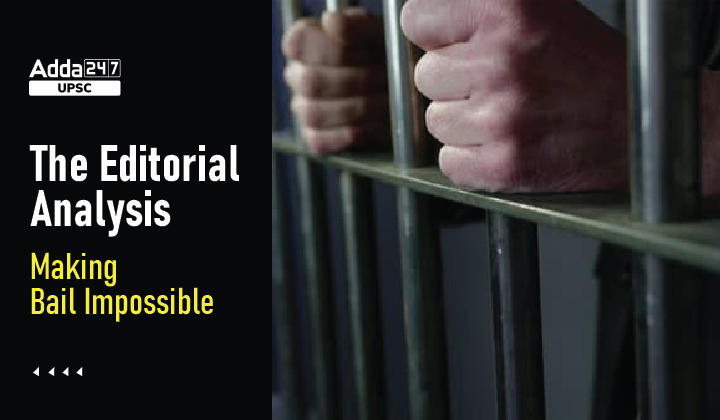Table of Contents
Making Bail Impossible- Relevance for UPSC Exam
- GS Paper 2: Welfare schemes for vulnerable sections of the population by the Centre and States and the performance of these schemes;
- Mechanisms, laws, institutions and Bodies constituted for the protection and betterment of these vulnerable sections.
Making Bail Impossible in News
- Recently, in Vijay Madanlal Choudhary v. Union of India case, the supreme Court upheld the constitutionality of the Prevention of Money Laundering Act (PMLA), is proof that the ghost of ADM Jabalpur has been resurrected.
- The old maxim of bail being the norm and jail the exception has been judicially cremated with this decision. Bail is now not even an exception; it is impossible.
Concerning Bail Provisions under PMLA
- Section 45 of the PMLA: To be eligible for bail, the arrested person must persuade the court that there are reasonable grounds for believing that he is not guilty of the money laundering offences brought by the Enforcement Directorate (ED).
- The onus is on the accused to prove that an event did not transpire. If he cannot do this, he will continue to languish in jail.
- Judicial Observation: To justify this high bar, the court overturned its decision in Nikesh Tarachand Shah v. Union of India (2017).
- In above case, SC had directed treating the offence of ‘money laundering’ as less heinous and therefore differently a crime from ‘terrorism’ under the Terrorist and Disruptive Activities (Prevention) Act (TADA).
- The court stated that the offence of money laundering was as heinous as a terrorist act and as great a danger to the sovereignty and integrity of our country.
- Associated Concerns: SC ignored the fact that under the PMLA, money laundering also covers monies associated with offences relating to infringement of copyrights and trademarks, arts and antiquities, securities, information technology, companies, and air and water pollution.
- Secrecy: The court also declared that the ED does not need to share the Enforcement Case Information Report (ECIR) with the accused.
- This is bizarre because the same notion of secrecy is not applicable to equivalent documents (FIRs) for agencies like the police and the Central Bureau of Investigation.
- The ECIR contains the rationale for the ED to register the offence. However, the court chose not to equate the ECIR with an FIR.
Conclusion
- When someone is arrested for an offence under the PMLA, he will be placed in prolonged incarceration without being told the specifics of why this is so. And no court will ever be able to reasonably conclude that the person is entitled to bail under the law as it now stands.
PMLA and FEMA- Controlling Money Laundering




 TSPSC Group 1 Question Paper 2024, Downl...
TSPSC Group 1 Question Paper 2024, Downl...
 TSPSC Group 1 Answer key 2024 Out, Downl...
TSPSC Group 1 Answer key 2024 Out, Downl...
 UPSC Prelims 2024 Question Paper, Downlo...
UPSC Prelims 2024 Question Paper, Downlo...
